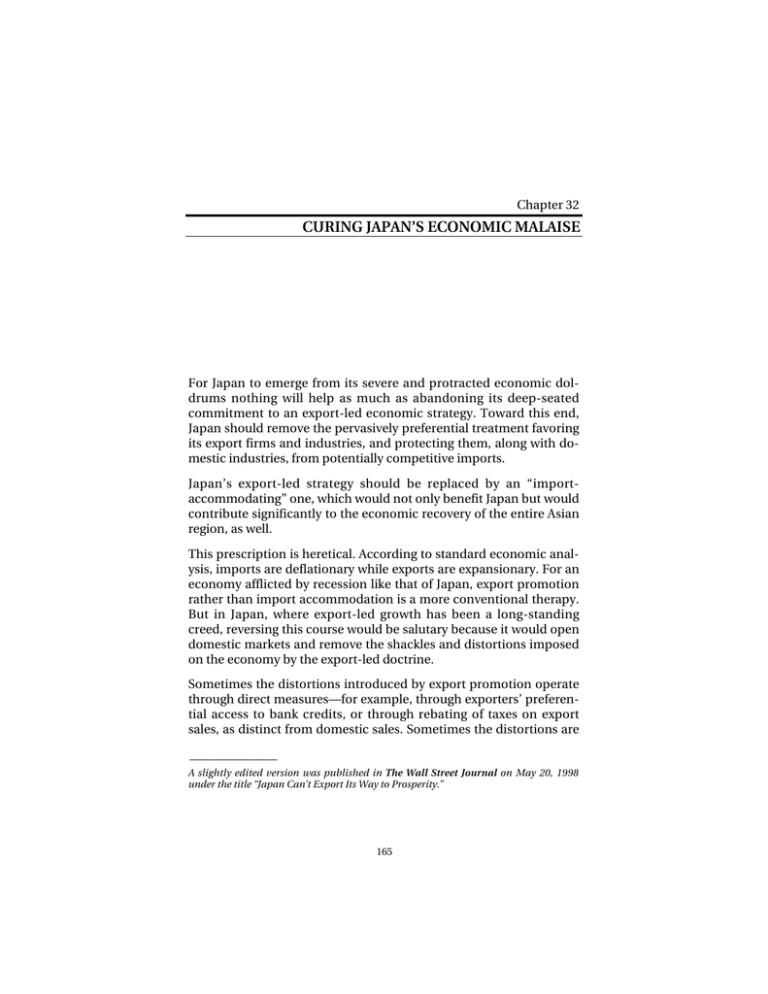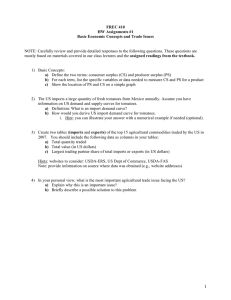CURING JAPAN’S ECONOMIC MALAISE
advertisement

Chapter 32 CURING JAPAN’S ECONOMIC MALAISE For Japan to emerge from its severe and protracted economic doldrums nothing will help as much as abandoning its deep-seated commitment to an export-led economic strategy. Toward this end, Japan should remove the pervasively preferential treatment favoring its export firms and industries, and protecting them, along with domestic industries, from potentially competitive imports. Japan’s export-led strategy should be replaced by an “importaccommodating” one, which would not only benefit Japan but would contribute significantly to the economic recovery of the entire Asian region, as well. This prescription is heretical. According to standard economic analysis, imports are deflationary while exports are expansionary. For an economy afflicted by recession like that of Japan, export promotion rather than import accommodation is a more conventional therapy. But in Japan, where export-led growth has been a long-standing creed, reversing this course would be salutary because it would open domestic markets and remove the shackles and distortions imposed on the economy by the export-led doctrine. Sometimes the distortions introduced by export promotion operate through direct measures—for example, through exporters’ preferential access to bank credits, or through rebating of taxes on export sales, as distinct from domestic sales. Sometimes the distortions are ______________ A slightly edited version was published in The Wall Street Journal on May 20, 1998 under the title “Japan Can’t Export Its Way to Prosperity.” 165 166 Straddling Economics and Politics indirect—for example, central bank sales of Japanese yen and the rhetorical flourishes of the éminence grise of Japan’s economic policies, the Vice Minister of Finance, Eisuke Sakakibara—designed to weaken the yen and thereby strengthen the competitive position of Japanese exports. Similarly, protection from import competition is sometimes provided by direct measures—for example, import quotas and tariffs. More often, protection is provided by labyrinthine regulatory restrictions in the form of non-tariff barriers—for example, exacting, changeable, and arbitrary customs procedures, standards for inspecting, testing, certifying, and approving import products, restrictions on entry of foreign firms into particular industries and on bidding by foreign firms for government contracts. In recent RAND research on the relative difficulty of doing export business in various foreign countries, a survey of several hundred key business executives in international firms found that Japan’s non-tariff barriers make it more difficult doing business there than in the United States, Europe or South Korea, and about as difficult as in China. Whether by direct or indirect means, and whether the means are designed to promote exports or restrict imports, Japan’s perennial pursuit of export-led growth accounts for many of the structural imbalances in its economy. One consequence is the continued amassing of large current account surpluses on top of its already excessive holdings of over $220 billion of foreign currency reserves (three times those of Germany, and about two-thirds as large as those of all fifteen members of the European Union!). During the past three decades, “export-led growth” (ELG) has been the mantra of development economics. In the 1960s, the underlying theory was that competition in export markets would contribute to improved efficiency and higher quality of export production and, over time, of production for domestic markets as well. In the policy domain, ELG has typically meant preferential attention to and emphasis on promoting exports as a means of boosting economic growth. The formerly-extolled “Japanese development model,” emulated and extended in Asia and elsewhere as the “Asian development model,” has had as its core principle both the nurturing of export industries, and their protection from import competition in domestic markets. Until the bloom wore off this rosy model in the summer of Curing Japan’s Economic Malaise 167 1997, ELG had registered significant accomplishments, not only in Japan but among the emulators—notably Korea, Malaysia, and Indonesia, as well. But the doctrine has also had many perverse consequences, which have contributed to Japan’s own financial crisis, as well as that of the Asian region. Export-led growth has several conspicuous flaws: • The mercantilist mindset underlying it views exports as “good” and imports as “bad.” This accords neither with economic sense, nor with common sense. Properly viewed, exports are the lowestcost means of paying for imports, while it is imports that provide real resources to boost investment and consumption. • ELG, in its Japanese form and that of its other Asian variants, has created structural imbalances and allocative distortions that impair efficient use of resources. Exports have received favored treatment at the expense of domestic producers and consumers. One result has been to create enormous excess capacity in Japan’s steel, cars, chemicals, semiconductor, rubber products, and other export industries. • The ELG doctrine is, in practice, inextricably associated with the belief that exports should appreciably exceed imports—more broadly, that a country following this policy should register a surplus in its current account. This belief is, as a general rule, logically flawed: everyone’s exports can’t exceed imports, everyone can’t have a current account surplus! Someone has to import and, in the aggregate, current account surpluses somewhere must be balanced by current account deficits elsewhere. • For Japan to continue accumulating a large current account surplus, when elsewhere in Asia there is a compelling need to provide liquidity and service debt by selling exports to Japan, is anomalous and sharply counterproductive for Asia's economic recovery. Even in the midst of recent Japanese rhetoric and policy pronouncements about economic stimulus, deregulation, and liberalization, the Japanese policy triangle—bureaucracy, business leadership, and political establishment—is only willing to endorse reforms that minimize challenges to the export-led growth doctrine. So, for 168 Straddling Economics and Politics example, the most recently publicized stimulus package of $128 billion emphasizes government spending on infrastructure and construction that will largely if not entirely exclude contracts for foreign firms. Tax relief for consumers is relatively small (less than onequarter of the stimulus package) as well as temporary, thereby assuring that most if not all of the concession will contribute to increased savings rather than consumer spending. To be sure, there is new talk of “deregulation” and “liberalization” associated with the stimulus package. But these measures do not involve removal of non-tariff barriers, or opening of domestic markets to imports; they simply allow some opening of Japan’s financial markets to foreign providers of financial services—a welcome change, but one that is likely to help rather than hinder Japanese exports. It is time—indeed it is well past time—for Japan to acknowledge the flaws in its export-led growth strategy, and to replace it with an “import-accommodating” strategy. This would focus on macroeconomic and microeconomic policies that would be neutral with respect to exports and imports, neither favoring the one nor inhibiting the other. Japan's leadership—and especially its sophisticated bureaucracy—should design an import-accommodating growth strategy to include the following elements: • Rapid reduction, leading to removal, of all forms of preferential treatment of export firms and industries, and of non-tariff barriers that inhibit import competition. • Permanent reductions of individual and corporate income taxes to levels that are at or below those in the United States and other successfully-growing developed economies, as well as permanently removing the consumption tax on domestic sales that was initiated several years ago; in conjunction with the preceding point, domestic demand for imports will rise, economic growth will resume, and the tax base will expand. • Planning for a current account deficit over the next five years that would aim to draw down Japan’s excess foreign exchange reserves by at least $50 billion to a more than ample level of $170 billion. Curing Japan’s Economic Malaise 169 This is admittedly a tall order. From the standpoint of reversing Japan’s economic doldrums, and especially those of its neighbors, it is long overdue. Postaudit The drawbacks of Japan’s pervasive and protracted mercantilist policies are even more evident now than when this was written in 1998. And the recommendations made in the article for reversing Japan’s stagnation remain relevant as well as ignored. For example, instead of drawing down its large foreign exchange reserves, Japan has more than doubled them since 1998.





